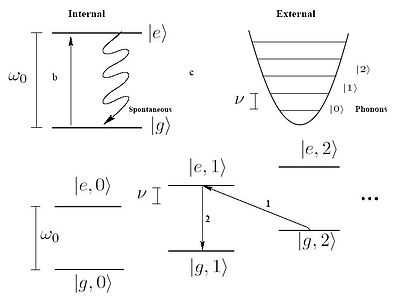Resolved sideband cooling

Resolved sideband cooling is a laser cooling technique that can be used to cool strongly trapped atoms to the quantum ground state of their motion. The atoms are usually precooled using the Doppler laser cooling. Subsequently the resolved sideband cooling is used to cool the atoms beyond the Doppler cooling limit.
A cold trapped atom can be treated to a good approximation as a quantum mechanical harmonic oscillator. If the spontaneous decay rate is much smaller than the vibrational frequency of the atom in the trap, the energy levels of the system can be resolved as consisting of internal levels each corresponding to a ladder of vibrational states.
Suppose a two-level atom whose ground state is shown by g and excited state by e. Efficient laser cooling occurs when the frequency of the laser beam is tuned to the red sideband i.e.
 ,
,
where  is the internal atomic transition frequency and
is the internal atomic transition frequency and  is the harmonic oscillation frequency of the atom. In this case the atom undergoes the transition
is the harmonic oscillation frequency of the atom. In this case the atom undergoes the transition
 ,
,
where  represents the state of an ion whose internal atomic state is a and the motional state is m. This process is labeled '1' in the image to the right.
represents the state of an ion whose internal atomic state is a and the motional state is m. This process is labeled '1' in the image to the right.
Subsequent spontaneous emission occurs predominantly at the carrier frequency if the recoil energy of the atom is negligible compared with the vibrational quantum energy i.e.

This process is labeled '2' in the image to the right.
The average effect of this mechanism is cooling the ion by one vibrational energy level. When these steps are repeated a sufficient number of times  is reached with a high probability.[1]
is reached with a high probability.[1]
References
- ↑ A.SCHLIESSER,R. RIVIÈRE, G. ANETSBERGER, O. ARCIZET,T. J. KIPPENBERG "Resolved-sideband cooling of a micromechanical oscillator", nature physics, Vol 4 MAY 2008.